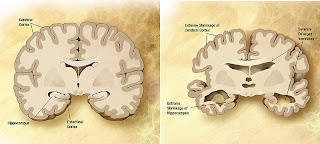Alzheimer’s Disease (AD)
is one of the most devastating illnesses that the human race has ever
faced. It literally destroys the brain, which shrinks as a result over
time. The toll of AD is not only measured in hundreds of billions of dollars in health care.
costs and millions of deaths, but also in personal and family tragedy
that comes with the severe loss of memory that accompanies it.
Remarkably,
scientists and doctors are getting good at predicting who has
pre-clinical AD or who will ultimately get AD before patients are even
symptomatic. But is knowing of any good if we can’t do much about it?
How can AD be prevented, delayed, or treated? The simple answer is that nobody really knows.
There are three key possible approaches to using stem cells to treat AD.
1)
One avenue is to use stem cells to regenerate or literally regrow
diseased parts of the brain. This is what people most commonly think of
when they conceive of treating AD with stem cells. The problem with this
approach is that the architecture of the brain is physically integral
to memory so even if we could grow a fresh, young part of the brain to
replace one ravaged by AD, there would be no memories there. It would be
like wiping the plate clean. In theory perhaps the person could make
new memories going forward in life that could be remembered or they
could be re-educated, but this is not what most people imagine as a
successful treatment for AD.
2) Another approach is to use stem
cells such as mesenchymal stem cells (MSC) not as rebuilding agents, but
rather as healers of the existing brain parenchyma. In this way of
thinking, MSC could heal rather than replace neurons for example. MSC
are kind of akin to the natural doctors of the body and could have
anti-inflammatory and other powers that might ameliorate AD.
3) A
third concept is using stem cells such as MSC as drug delivery agents.
So for example, instead of giving Crenezumab or some other drug
systemically, it is possible that stem cells could directly deliver the
drug within the brain from cell-to-cell far more effectively. Orders of
magnitude more effectively.

No comments:
Post a Comment